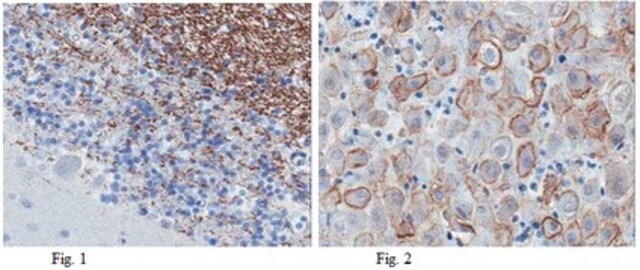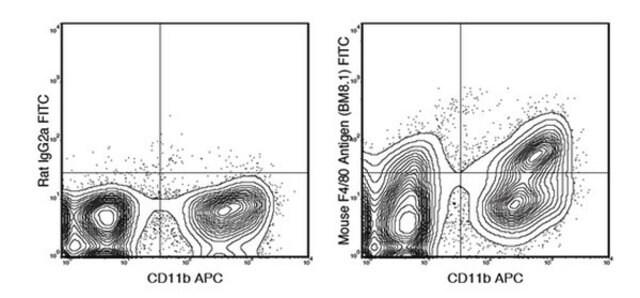MAB5442
Anti-Collapsin Response Mediated Protein 5 Antibody, clone CR-1
culture supernatant, clone CR-1, Chemicon®
Synonym(s):
CRMP5, DRP-5, ULIP-6, CRAM
About This Item
Recommended Products
biological source
rat
Quality Level
antibody form
culture supernatant
antibody product type
primary antibodies
clone
CR-1, monoclonal
species reactivity
rat, human, bovine
manufacturer/tradename
Chemicon®
technique(s)
immunohistochemistry: suitable
western blot: suitable
isotype
IgG1
NCBI accession no.
UniProt accession no.
shipped in
dry ice
target post-translational modification
unmodified
Gene Information
human ... DPYSL5(56896)
Specificity
Immunogen
Application
Neuroscience
Growth Cones & Axon Guidance
Immunohistochemistry: 1:50-1:200 on bovine retina frozen sections fixed with 10% formalin. No reactivity on mouse cerebellum.
Protein isolation: Bound to Bio-Rad′s Affi-gel (cat# 153-6046) to pull out native CRMP-5 from aqueous extracts of brain.
Optimal working dilutions must be determined by end user.
Physical form
Storage and Stability
Uses of the CR-1 and CR-3 antibodies are covered under pending patent application(s) assigned to the Mayo Foundation for Medical Education and Research (MFMER) and are proprietary to MFMER. Academic not-for-profit research institutions are granted an automatic license with the purchase of this product to use the antibody only for internal, non-sponsored, non-commercial, academic research purposes which license specifically excludes the right to sell, or otherwise transfer the antibody or its derivatives to third parties. In accepting this license, all users acknowledge that the CR-1 and CR-3 antibodies are experimental in nature. MFMER makes no warranties, express or implied of any kind, and hereby disclaims any warranties, representations, or guarantees of any kind as to the CR-1 and CR-3 antibodies, patents or product. All others are invited to request a license from MFMER prior to purchasing this antibody or using it for any purpose. For license information, please contact Mayo Medical Ventures, Office of Technology Commercialization at (507) 284-8878.
Legal Information
Disclaimer
Not finding the right product?
Try our Product Selector Tool.
Storage Class
10 - Combustible liquids
wgk_germany
WGK 1
flash_point_f
Not applicable
flash_point_c
Not applicable
Certificates of Analysis (COA)
Search for Certificates of Analysis (COA) by entering the products Lot/Batch Number. Lot and Batch Numbers can be found on a product’s label following the words ‘Lot’ or ‘Batch’.
Already Own This Product?
Find documentation for the products that you have recently purchased in the Document Library.
Our team of scientists has experience in all areas of research including Life Science, Material Science, Chemical Synthesis, Chromatography, Analytical and many others.
Contact Technical Service








